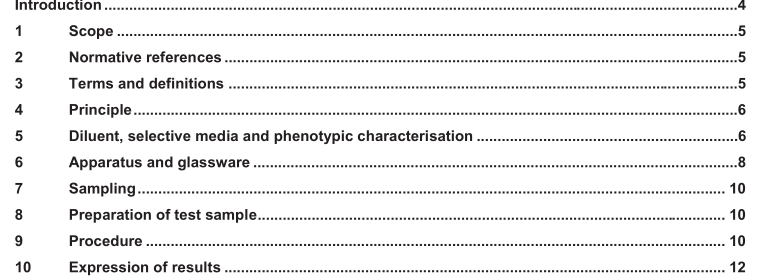EN 15787:2009 – Animal feeding stuffs – Isolation and enumeration of Lactobacillus spp.

1 Scope
This European Standard defines general rules for the enumeration of probiotic lactobacilli in feed samples (additives, premixtures and feeding stuffs) that contain lactobacilli as a single bacterial component or in a mixture with other microorganisms. This standard is not applicable to mineral feeds, which are defined as complementary feeding stuffs composed mainly of minerals and containing at least 40% crude ash (Council Directive 79/373/EEC [3]).
There are different categories of feed samples:
a) Additives containing about 10 10 colony forming units (CFU)/g;
b) Premixtures containing about 10 8 CFU/g;
c) Feeds, meal or pellets, which contain about 10 6 CFU/g and include complete feeding stuffs and milk replacers.
The detection limit is as defined in EN ISO 7218.
2 Normative references
The following referenced documents are indispensable for the application of this document. For dated references, only the edition cited applies. For undated references, the latest edition of the referenced document (including any amendments) applies.
EN ISO 6887-1, Microbiology of food and animal feeding stuffs – Preparation of test samples, initial suspension and decimal dilutions for microbiological examination – Part 1: General rules for the preparation of the initial suspension and decimal dilutions (ISO 6887-1:1999)
EN ISO 7218, Microbiology of food and animal feeding stuffs – General requirements and guidance for microbiological examinations (ISO 7218:2007)
ISO 6498, Animal feeding stuffs – Preparation of test samples
3 Terms and definitions
For the purposes of this document, the following terms and definitions apply.
3.1
lactobacilli (described by their characteristics as used for this standard)
lactobacilli are bacteria which form colonies fitting the description of these species on the specified selective edium after incubation of 48 h to 72 h at a temperature of 37 °C under anaerobic conditions [4]:
Morpholoy of colonies:
a) circular;
b) regular or irregular (starry) surrounding;
c) convex or conical;
d) dull or glistening surface;
e) translucent, white, pale green, dark green.
Colony size varies between 0,5 mm and 3 mm in diameter.
Phase contrast microscopic a examination of selected colonies shows that cells are varying from long and slender sometimes bent rods, to short, often coryneform coccobacilli and chain formation is common.
NOTE For a detailed account of morphology see [4].
4 Principle
a) Preparation of sterile and dry poured agar plates.
b) Drawing a representative test sample under sterile conditions.
c) Preparation of the initial suspension to obtain a homogeneous distribution of bacterial cells from the test ortion.
d) Preparation of further decimal dilutions of the initial suspension in order to reduce the number of microorganisms per unit volume to allow, after incubation, the counting of colonies.
e) Inoculation of the prepared plates with an aliquot of the optimum dilutions and dispersion of the inoculum by using a sterile spreader.
f) Incubation of inverted plates for 48 h to 72 h at 37 ºC ± 1 ºC, under anaerobic conditions.
g) Counting of typical colonies, considering the specific properties of lactobacilli.
h) Morphological verification of isolates within the Lactobacillus genus through the use of microscope analysis.
i) Calculation of the colony count per gram or kilogram of feed sample.
5 Diluent, selective media and phenotypic characterisation
5.1 Diluents
5.1.1 Diluent for initial suspension of premixtures, additives and feeding stuffs
This diluent is used to decimally dilute the sample to prepare an initial decimally sample suspension (10 -1 ) in appropriate containers (e.g. universals, bottles or flasks).
EN 15787:2009 – Animal feeding stuffs – Isolation and enumeration of Lactobacillus spp.